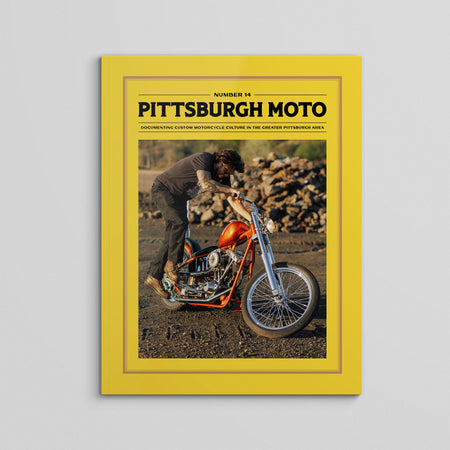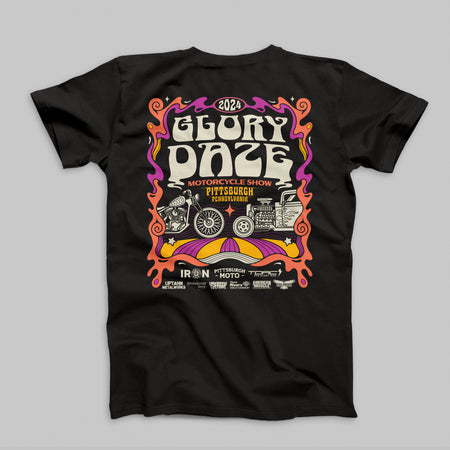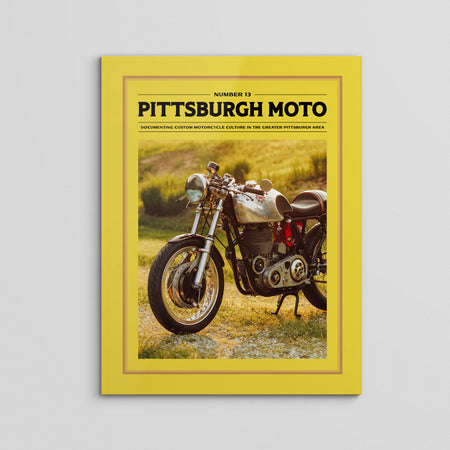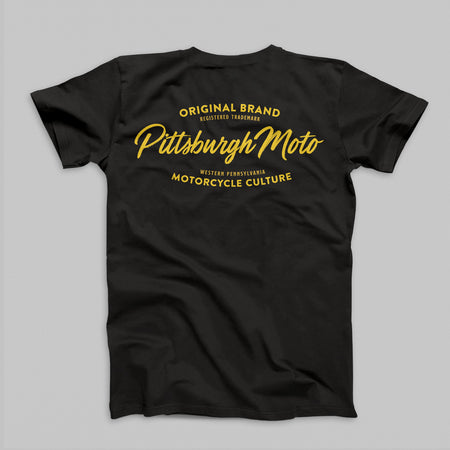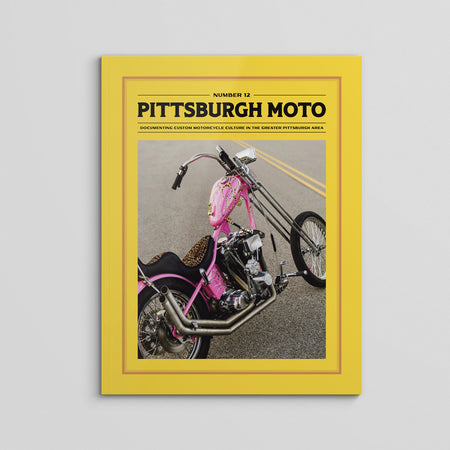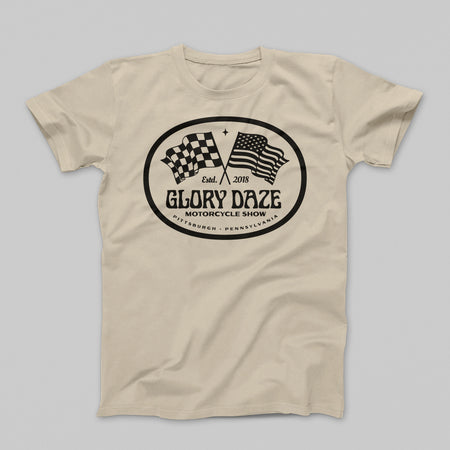
Issue Number 14
Choppers and cafe racers and drag bikes, oh my! Issue Number 14 is here with more Pittsburgh motorcycle goodness.
This is the last issue in the subscription format, but Pittsburgh Moto isn’t going anywhere. We’re going to shift the focus as a whole, putting more effort into new products and events while continuing to feature local content on our media outlets. Stay tuned!

Orange Crush Shovelhead
Piecing Together A Classic Chopper Words by Kurt Diserio — Photos by Alexa Diserio It’s an awful feeling not having a running bike ready to go when the weather starts to warm. Heath Hildreth’s previous bike that we featured in issue Number 009, a Harley-Davidson Sportster chopper appropriately nicknamed “The Curse”, was quite the headache. The constant issues left him with the chopper blues. To make things right, Heath decided to start fresh with a shovelhead engine. The goal was to build something the right way in a similar style as his Sportster. The results were promising. Alexa and I met up with the young chopper enthusiast in nearby Follansbee, West Virginia, to learn how the bright orange build came together. We featured your Sportster in an earlier issue. How did this shovelhead come together?Heath Hildreth: I just wanted to throw together a bike to have a chopper to ride. After my Sportster gave me issues, I started piecing stuff together. I had nice stuff already and wanted to keep the same look, so some of the Sportster stuff was recycled into the new bike. I bought a new tank and fender but kept it the same style. The seat, brakes, and wheels were taken from the Sportster. I had an idea of what I wanted in my head and didn’t want to half-ass it, but the goal was to simply get something on the road while making it look as pretty as I could. What was it like going without a bike to ride for that period?HH: Dude, I didn’t feel like myself during that time. You don’t want to ride anything else after riding something that feels like an extension of yourself. Where did you find the parts?HH: I’ve tried to do research, but think it’s either an old AEE or Corbin-Gentry frame. I like the stance and the square tubing. It just fits with the sharp lines on the oil tank and square headlight. I picked up the front end, the frame, the motor, and a set of wheels that I’m not using right here in Follansbee, West Virginia. I went out on my lunch break and looked at it. The dude is an old Ford guy who had an Evo chopper. It was cool to stop by after I finished it to show him. He was pumped. I bought an aftermarket V-Twin transmission in Burgettstown, Pennsylvania. I’m using a Gasbox oil tank, Gasbox exhaust, Lowbrow Customs tank and fender, and Old Gold Garage seat. The handlebars and sissy bar were made custom by Hunter Norman, as well as a lot of the welding and fabrication. He’s really particular and took my ideas to come up with something even better. I had them chromed, along with as much little shit as I could like the foot controls, oil tank, and main drive. Who did the engine and paintwork?HH: I got the top end done by Dennis at Mary’s Motorcycle Haven in Burgettstown. He dialed my bike in and I highly recommend him to anybody. I don’t want to jinx it, but it’s been a one-kick bike and super reliable. Fred Marino of Wellsburg, West Virginia, did the paint. I was stuck on it for a while, and being colorblind doesn’t make it easy. He would send me photos of paint on cars and bikes, and we both kind of agreed on something together. He did such a great job, and people seem to really like it. Are there any other parts or work you want to mention? HH: My neighbor, Matt, made the air filter. It’s an old vintage Vanguard fire alarm. I was getting ready to load it up for Glory Daze last year, and he came over with it. He took a lot of time to make it, and it brought a tear to my eye. He was nervous because he knew I was picky about my bike, but it was perfect and fit the bike so nicely. He makes knives for fun and helped me out a good bit with the bike. Anytime I needed another set of hands, he’d come straight over to help. When did you finish it?HH: I remember taking photos of it around Easter last year when it was just thrown together. I figured, let’s just try to fucking start it and see what happens. It ran for a little bit but wouldn’t start when it was too hot. I didn’t want to go through that again, so that’s when I took it apart and reached out to Mary’s Motorcycle Haven. It had two different jugs on it. One was a 74-inch jug and the other was an 80-inch with a different number of cylinder fins. I just wanted to do it right this time. What's it like now?HH: It’s set up for me. I can just hop on and enjoy it. Once I got the engine back, we went to Myrtle Beach fall bike week and had a good time. It was cool having the only chopper there in a sea of baggers and regular bikes. People were fascinated that it was a kickstart-only bike. They just thought that was the craziest thing ever, even though it’s normal to us. I love being able to start it and ride it for hours without a hassle. Everything went together really smoothly. Featured in Issue 14 1979 Harley-Davidson FXEFBuilt by HEATH HILDRETHinstagram Words by KURT DISERIOPhotos by ALEXA DISERIO

Identity Crisis
Custom 1982 Yamaha XV750 Words by Kurt Diserio — Photos by Alexa Diserio Ah! Something different. Yes, we’ve been through waves of the cafe racer craze, but still, it’s nice to see a Yamaha Virago getting some love. Especially when it’s as crisp and clean as the build by Pittsburgh’s Sam Tomer. As someone who just got their first motorcycle only four years ago, it’s impressive to see the progress made. We were excited to meet up with Sam in Sewickley to get some photos and talk bikes. First off, why a Yamaha Virago? Can you give us the backstory of how this build came about?Sam Tomer: I seem to always find myself called to not-so-attractive bikes in stock form. It’s a challenge to try and find ways to recreate and change the lines of a motorcycle. I love it when people are like, “What is that?” They’re shocked to hear that it’s a bike they’ve seen a hundred times, or have even ridden back in the day. I’ve always had my eye on a Virago, but unfortunately, most are just roached or so far butchered. I found this one in Cleveland and drove out the next day to grab it. It had a clean title and verified 5,000 miles. I just couldn’t pass it up. I almost bought one a year prior, and I’m glad I did not. This one just felt like the right time and place for what this build would inevitably be. Was there an inspiration for the direction you went as far as the bike’s style?ST: Every time I start a project, I do a ton of research to see what’s out there. What’s possible? What am I capable of? What has already been done? And so on. Much of the inspiration came from Virago builds by Craig Jackson and De Stijls. They just completely transformed them. There are a lot of aftermarket and pre-made parts for the Viragos. Although they are really cool, it’s been done quite a bit. I wanted something a little different from the rest. One of my favorite bikes was my friend’s Suzuki GS 550E, of which I’ve always loved the gas tank. So, I chose to modify the tank to fit. I was tossing around color schemes in my head, and out of nowhere, my stepdad pulled up in his new mint green Fiat 500. I knew that was going to be the color. The subframe is off of a 1979 CB750 Super Sport donor bike that I had lying around the shop. I didn’t really push the bike in any kind of direction, it just seemed to build itself in a weird way. I just let it happen organically. What were some of the stand-out parts of the build that you’d like to mention?ST: I try to sharpen my skills with every build I do. This was the first front/rear-end conversion I’ve ever done. A little machining of the rear hub was necessary to accommodate a larger rear wheel and tire. I definitely got more familiar with my welder designing the subframe and refitting the gas tank. I love the process of painting. Especially when you have to make a clapped-out 40-year-old gas tank look presentable and functional on a frame it wasn’t meant to be on. This was just a lot of fun refining what I’ve already learned on other projects. Did you have any moments of the build that were either interesting, arduous, or meaningful?ST: This bike was my no-compromise build. I thought I would run into a lot of roadblocks and adversity as others in the past have been. But honestly, this thing came together in under two months. Mainly because I’d have to burn the midnight oil after working 10-hour days. Nothing on this bike really gave me trouble. I spent more hours sitting in my chair smoking cigarettes and drinking coffee just visualizing each process and not jumping ahead of myself and getting discouraged. Some things don’t work out like you think they will, but that’s probably because there’s a better way. I think visualization is what I learned most about this—to slow things down and letting inspiration in. Let it be fun and not become a job or task. The bike traveled south to the Handbuilt Show in Austin, Texas this year. How was that experience? ST: Man, it was such an honor to attend the Handbuilt Show this year. To be in the same room as some of the builders I look up to from all over the world was just a full-circle moment. The folks at Revival Cycles were so accommodating and definitely put on a proper one. Super chill vibe at such an amazing venue. Austin is a really dope city. We stayed there for a week and had the time of our lives. In such a crazy, hectic, rat-race world, it’s nice to find reasons to get away every once in a while. How has your motorcycle experience been with Pittsburgh?ST: I’ve lived in Pittsburgh my whole life. Although visiting Texas and other states is great, there’s nothing like home. Maybe I’m just biased or like to stay in my comfort zone, but Pittsburgh just has so much variety. I wouldn’t want to be anywhere else. I got my first motorcycle a little over four years ago, not knowing how to ride. Then COVID hit, and I tore that bike down and built it up in a little 7x7 shed barely big enough to stand up in. Since then I probably have a dozen builds under my belt, a shop with a paint booth, and a big enough space to have no excuses. I really got bit by the bug quickly. I don’t build the bikes for money. In fact, I have a problem with getting rid of them. Wrenching on these old pieces of metal has truly become a passion, an outlet, and a therapeutic way of expressing myself. The best part is you can jump on and ride your creation. To put your vision in motion. Some of my favorite local roads are out by the shop in McKeesport. There’s a lot of beautiful riding and twisties out near Raccoon Creek State Park. It’s always fun to have a nice night ride through the city, too. Anyone you’d like to thank or mention who was involved with the build?ST: None of this would be possible without my lady. She holds it down and allows my dreams to happen. There are times when I don’t come home until five in the morning covered in oil and smelling like gas. She, my two sons, and my family are my biggest fans and source of inspiration. All of my buddies are so encouraging and give me creativity when I need it most. The folks who trusted me to work on their bike were pivotal in my progression. Each of the builds I do has a piece of me and is a direct reflection of myself—good, bad, and in between. Featured in Issue 14 1982 Yamaha XV750Built by SAM TOMER Words by KURT DISERIOPhotos by ALEXA DISERIO

XL883 Chopper
Keeping It Local Words by Kurt Diserio — Photos by Alexa Diserio We’ve covered many different Sportster builds over the years. Each one helps solidify it as one of the most versatile and influential bikes ever produced. It also serves as one of the best entryways into custom choppers. With an aftermarket full of attainable parts, it’s no wonder the Sportster platform is so popular. Stewart Owens of Delmont, Pennsylvania, grew up around bikes, watching motocross legends soar around Steel City Raceway. He got the chopper itch after visiting some East Coast shows, picked up a stock Sportster, and never turned back. The build is a great representation of a community helping to bring a bike to life. What’s the backstory of the bike?Stewart Owens: After going to shows like Cheap Thrills and Glory Daze, I knew I wanted a rigid chopper. I bought the bike for pretty cheap during COVID and just had a bunch of friends help me out. It was completely stock at first, so I started doing the frame little by little. It was my first time cutting a frame, and I was super nervous about it. I would just watch YouTube videos and talk to people who helped guide me through. I tried to keep most of the work local in the Pittsburgh and Delmont areas. Things took off after I got in touch with Josh from Uptahn Metalworks in Pittsburgh. When did the chopper switch go off?SO: I’ve had Harleys since I was roughly nineteen or twenty years old. After going to Cheap Thrills in 2017, I decided to build a chopper. I was talking to a lot of guys in the community. My buddies and I started traveling to different chopper events and shows. Everyone was so welcoming, so I knew I wanted to get more involved. How did Josh at Uptahn help with the build?SO: He did a lot of the work on the seat and was a big help with the fabrication. He shaved the forks, made the mini floorboards, the sissy bar, and more. Did you have something in mind at the start?SO: I wanted something small and tight that I could rip around town on. For as tiny as it is, it handles well and turns great. It’s very smooth. Where did you find the parts you wanted to use?SO: Mostly from going to shows, talking to other people, or just looking through magazines and online. I feel like social media plays a big part in all of this stuff now. Are there any standout pieces you’d like to mention?SO: I love the floorboards, the paint, the seat, and the whole stance of the bike. I feel everything flows very well. Nick from Two10 made the handlebars. The exhaust is from Lowbrow Customs. Some other stuff is from TC Bros. Sportsters have so many options and websites you can use. Everything is reasonably priced. Who did the seat and paint?SO: John from Uptahn did the seat pan, and Weimann Interiors in Delmont did the rest. Aaron Anderson of Picasso Auto Body here in Delmont did the paintwork. What is it about the motorcycle community that stands out to you?SO: I enjoy the connection and being able to relate to the older crowd. My grandfather rode motorcycles, and it kind of brings you back to how they rode and appreciated them. That generation was more hands-on. I’ve noticed a lot of kids taking a passion for the more old-school bikes and choppers and reaching out to the older gentlemen who lived in that era. You’re from the Delmont area. Did you go to Steel City Raceway growing up?SO: I grew up riding dirt bikes, so I went to all the local tracks like Steel City and High Point. My aunt and uncle bought me my first PW50 when I was four years old, and I had a passion for it since. I didn’t race much but was around Mad Mike Jones and those guys. I remember being young when it got rowdy. I still travel a lot to the motocross races. Any shoutouts?SO: I’d like to thank Picasso Auto Body, Josh from Uptahn Metalworks, Weimann Interiors, and all my friends and family who helped with the bike. Featured in Issue 14 1997 HARLEY-DAVIDSON XL883 SPORTSTERBuilt by STEWART OWENSinstagram Words by KURT DISERIOPhotos by ALEXA DISERIO

TE Customs
the Artist Behind the Brush Words by Kurt Diserio — Photos by Alexa Diserio It’s tough to put your finger on the paint style of Tyler Elliott of TE Customs. It ranges from the classics of the past to weird custom characters and everything in between. Over the years, many of the bikes throughout the pages of our publication have been painted or built by TE Customs, including the well-recognized Chromophobia shovelhead that graced issue No. 007’s cover. Since this is our last issue in the subscription format, it was only right that we visited his shop in Finleyville, Pennsylvania, to do a feature on the artist himself. You’ve been involved with art since you were young. How did that eventually lead to doing paint and fabrication work? Tyler Elliott: At a young age, I was always drawing cars, trucks, and motorcycles. My parents got me subscriptions to Hot Rod magazines, and I would draw the vehicles I saw throughout the pages, trying to copy them as close as I could. Then I discovered the Ed Roth/Rat Fink stuff. It was a big influence on my artwork and still is today. Seeing the custom cars in those magazines made me want to build my own hot rods and bikes, and that led to me learning how to fabricate my own parts. When did you develop an interest in motorcycles?TE: I had been mainly into cars up to that point—customizing and restoring them for a few years. I was mostly restoring first-gen Camaros full-time for a few years, and then I wanted to build a motorcycle mostly just to see if I could do it. A lot of my friends at the time had street bikes, but I had zero interest in them. I did, however, really dig the old Harley choppers. I had seen photos of my dad’s bikes from back in the day, as well as old chopper magazines, and I was like, this is what I want to build! That’s when I got my 1973 ironhead. I didn’t have plans to keep it at the time, just figured I’d build it to sell. That never happened. I’m still riding that bike to this day, along with a few other bikes I have built. Now I do bike paint and fabrication full-time. There’s quite a range of paintwork that you do. How would you best describe it?TE: It’s hard to narrow it down to just one style. I do pinstriping, lettering, flakes, candies, pearls, leafing, and airbrushing. I like the ‘60s and ‘70s style panels and flames. I also like the ‘80s and ‘90s bright neons, weird color combinations, dry brush lettering, and graphics. I’m always trying to outdo myself on each paint job. Trying different techniques or coming up with my own way of creating effects and graphics. I like making paint look a mile deep like you can almost dive into it and swim around. I like my artwork buried in clear, sanded, and polished so it looks like a piece of porcelain. On the flip side, if I’m doing a “survivor” with a weathered or patina look, I take extra care to make sure all of the dirt, wear, damage, and fading are in the correct locations. Do you have a favorite style to work on?TE: I’d say vintage bikes and cars—building and painting them in the style they used to be done back in the early days of choppers and hot rods. I like to put my own twist on them with some unique paint and hand-fabricated pieces. In addition to paint, what other type of work do you do here at TE Customs?TE: I try to limit myself to painting, fabrication, and more specialized stuff. I do general framework, hardtails, handlebars, pipes, or any fab or sheet metal work. When did the motorcycle work start to take off?TE: It wasn’t until the first Glory Daze in 2019 that I even knew there was a chopper scene around here. Guys started reaching out to me after seeing my bikes in magazines, and it started to get to where I thought I could start focusing on the bike stuff more. What’s the biggest hindrance in the paint world right now?TE: Paint is so expensive now, and materials just go up all of the time. I want to use the best products out there, but it’s getting to the point where there’s only going to be a certain group that can afford this stuff. Any advice you’d give someone who might want to get into this?TE: I’d say that if you’re going to start your own business, then take a business class. That end of it can be hard to grasp, but it’s necessary. When I first started, I figured it’d be easy, but there’s so much more to it. Take a class and study under someone to learn the business end of it. I also recommend lots of practice. It sounds generic to say, but you have to do it. Start simple, and avoid doing crazy graphics right away. It’s better to understand how paint works. Even if you’re doing one solid color, a million things can go wrong at any time, and it always does. A quote I heard was something like, “Anyone can make a perfect paint job once, but a good painter knows how to fix paint when it goes wrong.” There’s always something that happens and a professional knows how to correct that stuff mid-job. Featured in Issue 14 TE CUSTOMSTYLER ELLIOTT724-348-6703FINLEYVILLE, PAfacebook | instagram Words by KURT DISERIOPhotos by ALEXA DISERIO
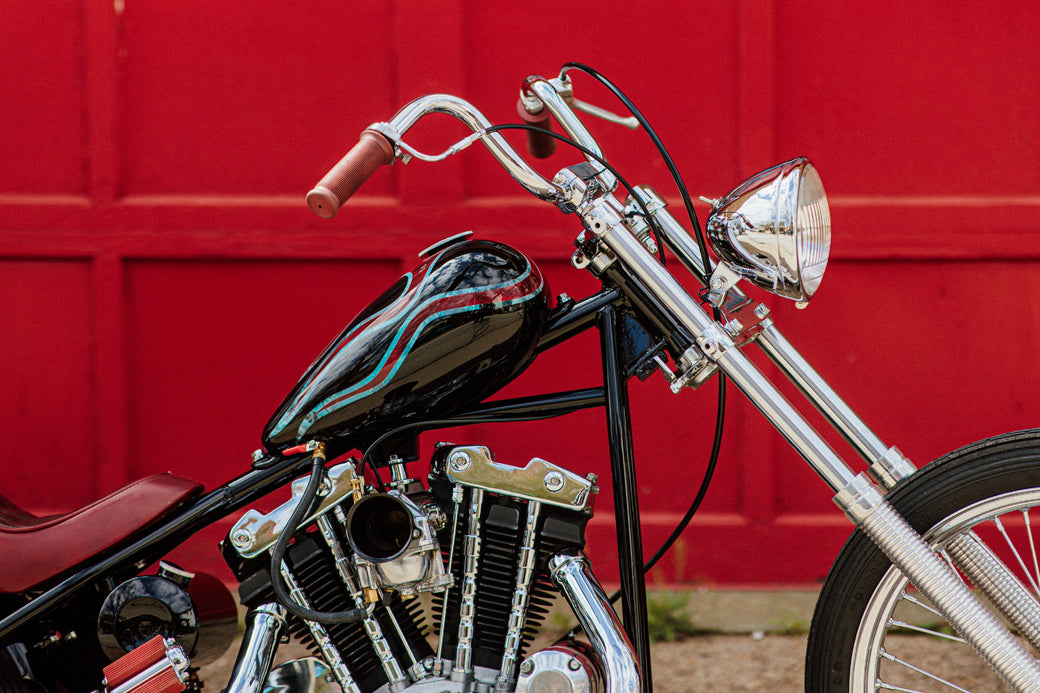
1974 Ironhead Chopper
A Drag Racer's First-Time Build Words by Kurt Diserio — Photos by Alexa Diserio Let’s face it. The world is much different than it used to be. Working on motorcycles and being mechanically intelligent isn’t something that most kids take an interest in these days, so coming across this Ironhead build from Tim Grabiak helps restore a little faith. Tim’s father, Jay, has been running Jay’s Paint and Performance in Greensburg, Pennsylvania for over twenty-six years. The shop deals mostly on the automotive side of things but proved to be the perfect place to learn the skills needed to produce the solid chopper build that you see here. We met up with Tim at his father’s garage to chat about the bike, the build process, and his interest in drag cars. Did your dad and his paint and performance shop play a role in your involvement with motorcycles?Tim Grabiak: Growing up, I’ve always been into old-school choppers and cars. I wanted a motorcycle of my own because my dad has always had them. I’d watch him come home on his old shovelhead. I grew up in the business and spent a lot of time working at the shop getting my hands dirty. How did this chopper get started?TG: This was my first build. My dad, Jay, picked the bike up in pieces. I got to choose between building this or a 1978 Honda, and I chose the Harley. I started building the bike when I was sixteen, just working with it here and there when I could. Last year, just before I turned seventeen, is when I really started thrashing on the bike to get it done in time for Glory Daze. It’s fun trying to hunt some of the parts down and find them as you go. When you buy something, you end up taking a truckload of parts with it, so a lot of stuff was just acquired, like the lower front forks. You don’t see those every day. Did a lot of the parts and pieces come from your dad’s shop?TG: Yeah, a lot of it did. Whatever pieces we had lying around, we tried to make it work or fabricate something just to make it look alright. The frame is a Paughco. The old seat was originally from my dad’s old Triumph. All of the work, including the paint, was done here at the shop. Was there something about choppers you enjoy that sent you in that direction?TG: I’ve just always been into that style. It’s not an average bike that you see anywhere else. It’s rare to see someone running around this small town on a chopper. These bikes see a lot of abuse, and it takes a mechanic’s ability to keep them on the road. Every part breaks, so you have to know what to do on the fly. You’re always problem-solving. You also drag race cars. What’s your history in that world?TG: The 1968 Camaro is my car. We bought that and threw it together in a week just to get it running. I had fun with the car for a couple of years, but this year it’s time to step it up. So I’m doing all new suspension, a rear end, everything. The whole drivetrain of the car is getting redone, as well as the roll bar, and interior. I’m looking for some fast numbers with it. Where do you normally run the drag car?TG: We do drag-and-drive events. So it’s five days, five race tracks. When you get to the first track, they impound your truck and trailer. You then have to pack everything in your hot rod and drive it across the country pretty much. So you’re doing over a thousand miles with all of your gear, go and make a pass, then hit the road again. You drive all night to the next track, get up, make a hit at the second track, and get back on the road. The events are five days of that. It’s a test of your mechanical skills to see if you can make the week. To me, building a car would be a lot more complicated than a bike. What are the similarities and differences?TG: Regarding the motor, all of the concepts are the same. It’s just a smaller platform. All of your braking is pretty much the same. The drum brakes are like the old Model T brakes from the 1930s. The big difference is that bikes are a lot lighter and less expensive compared to cars. How has the chopper been now that it’s finished?TG: Hopefully, this summer I can get out and ride it more. I finished it last summer but kept fighting with the transmission. I went through three transmissions before I finally got it working right. It felt good to pull it out from sitting all winter now that it’s fixed and ready. A couple of kicks, and it fires right up. Any future plans?TG: I have a hardtail frame for a Honda motor, so I might throw that together with a springer front end. It’d be nice to make it something a little different, and I have some options with all of the parts lying around. I don’t want a bike quite as nice as this one, so we’ll see. Featured in Issue 14 1974 Harley-Davidson Ironhead chopper Built by TIM GRABIAK instagram.com/tim_grabiak Words by KURT DISERIO Photos by ALEXA DISERIO
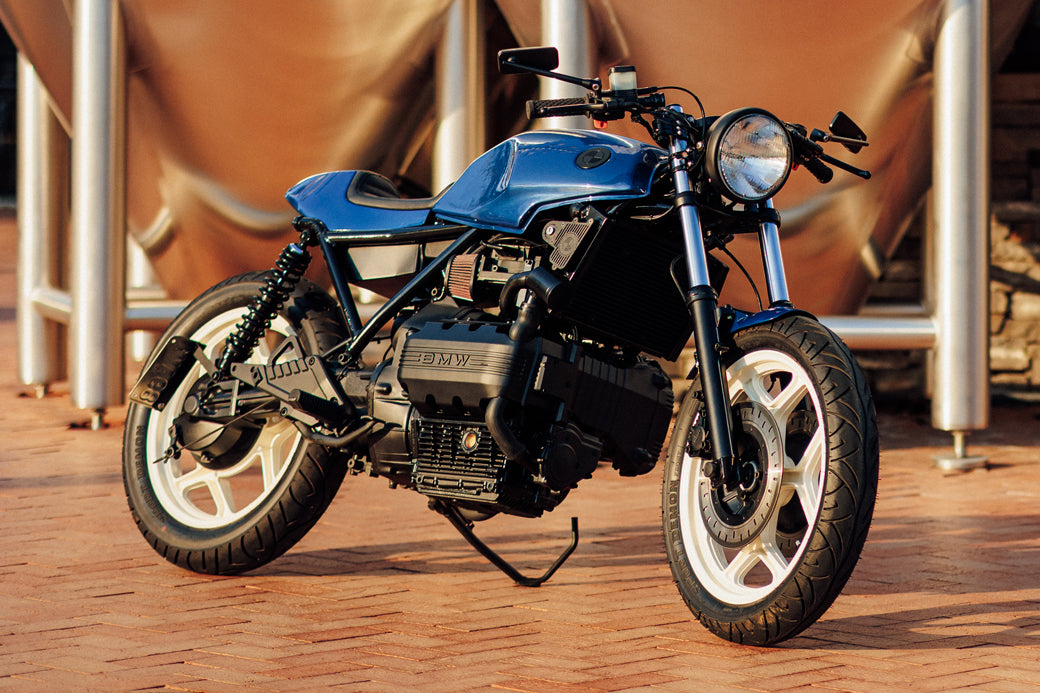
BMW Dragon
SG MOTO BUILDS A 1986 K75s CAFE RACER Words by Kurt Diserio — Photos by Alexa Diserio The BMW bikes we’ve featured throughout the years have had a variety of styles ranging from classic restorations to stripped-down customs. The inspiration for each has also been interesting. John Price, who uses his shop name, SG Moto, pulled from an interest in Moto GP to style his 1986 K75S featured here. The popular BMW K models have earned a reputation as sporty and reliable bikes, serving as a great cafe racer platform for cruising around Pittsburgh. We met up with John in the busy SouthSide Works to learn more about his vision for the bike. How did you come across the bike?John Price: I believe it was a Craigslist find. Potentially, Facebook Marketplace, but I was scanning all of the online selling platforms at the time. Did you have a vision for how you wanted the BMW to look or was it something that just happened over time?JP: Once I found the Twisted Brothers rear cowl for it, the design centered around that primarily and I wanted to keep it slim and minimalistic. Originally, I planned for a Moto GP look with circle number decals, a center stripe, and tire letters. Unfortunately, the final finish of the wheels came out to be a color I would not be able to match, so I omitted the decals and abandoned the full-race look. Is there something that draws you to this bike style?JP: My build style has always been inspired by vintage racing or Moto GP. My first custom bike was a bobber built on a platform that was too fast to be a bobber. I wanted the speed and power on a platform that made sense, so I started building cafe racer and Moto GP style bikes. The BMW was the perfect next step for me, as I am a German sports car enthusiast. The platform itself is very bare-bones in terms of necessary working parts. Being fuel-injected, the K75 had tons of power for its size, and with the modifications, it now makes even more. What is it about Moto GP that you enjoy?JP: Primarily it’s just the hyper-race style configurations of the bikes that pull my attention. The fairings, cowls, and windscreens, all purpose-built with speed in mind and dressed in number plates and motosport decals. The races they compete in are the pinnacle of the sport. Isle of Man TT? Top-tier Moto GP series? That’s the peak of road race performance. How does this bike compare to your other builds?JP: I knew this build would cost more and be more of a challenge than the Japanese inline four-cylinder platforms I was used to, but I thought it was time for something different. It was fun to build despite taking a lot longer and costing a lot more than expected, and I am pleased with the results. I didn’t know what to expect from the custom exhaust system, and the resulting tone is what I’m most pleased with. The majority of the compliments I get are for the sound of the exhaust system. I would absolutely build another K bike in the future–the distant future, as I need some recovery time after this one. What similarities do you see between German sports cars and their motorcycle counterparts?JP: The first bike was an opposed piston engine model designated R65. This would remind you more of the vehicles BMW produced in the 1940s and ‘50s when air-cooled engines were more prevalent. It takes some getting used to on a motorcycle. Those engines create forces that act on the bike in a way no other engine does. It’s a different kind of ride. The K75 is interesting, as it shares the same fueling and ignition components as the E30 series cars, which happens to be the generation I owned. It’s an aftermarket upgrade, but the throttle body I have installed on the K75 is from a BMW E30—K&N intake filter directly on the inlet port. This setup paired with a wide open exhaust is sure to produce significant power improvements on a fuel injected inline engine. Do you have any favorite roads around the Pittsburgh area? JP: In my cars, I have the most fun utilizing our complex highway interchange systems, as you can more or less create your own sort of circuits that are easily modified on a whim when traffic or construction gets in the way. The trouble is there’s almost always traffic, so it’s best to wait until the early morning hours to settle your grudge matches or finish your test and tunes. On a motorcycle, I prefer winding roads with steep elevation changes. I like to pretend I know what I’m doing on a race-built bike and lean into turns riding out a downshift, ready to accelerate through the apex. Don’t be fooled folks, I’m no race rider. Just a custom builder with a death wish I can’t seem to satisfy. Between my house and my shop, there is Glass Run Road, which has a few fun turns you could push hard through if there’s no traffic. It is dangerous though. Not the best area for this kind of thing. I rarely get to ride to explore new roads. Everything has been utilitarian for as long as I can remember. No fun and certainly no rest. Back to work, dummy. Describe your dream bike build or something that you would love to try next.JP: I’ve got to be honest here, I’ve been trying to get out of this hobby. It’s a very taxing lifestyle. I’ve said this before but keep doing things that pull me back in, like buying bikes on a whim or agreeing to help someone with theirs. If I was still a dreamer, I suppose I’d do another K bike, and just really nail every aspect of it the way I envision it. This would be a larger displacement model despite there being absolutely no need for someone my size to be on a bike that powerful. It would have a front end conversion from a modern performance bike and would look like a Moto GP series cup winner. I’d integrate as many of the signals and instruments as I could, and create the illusion that they weren’t even there until illuminated. Paint, decal placement, number circles, and raised tire letters would all coordinate to give it an imaginative scheme reminiscent of the best-looking bikes in the fastest circuits. This would take the most planning, I feel, as everything hinges on nailing that look. If I’m not satisfied, it’s not my dream. Featured in Issue 14 1986 BMW K75S Built by JOHN PRICESG MOTO instagram.com/sg.auto.moto.machine Words by KURT DISERIO Photos by ALEXA DISERIO

